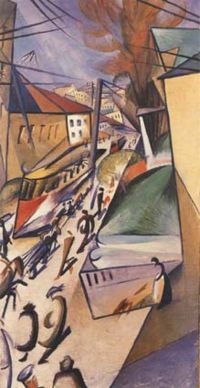
Ukrainian avant-garde is the avant-garde movement in Ukrainian art from the end of 1890s to the middle of the 1930s along with associated artists in sculpture, painting, literature, cinema, theater, stage design, graphics, music, and architecture. Some well-known Ukrainian avant-garde artists include: Kazimir Malevich, Alexander Archipenko, Vladimir Tatlin, Sonia Delaunay, Vasyl Yermylov, Alexander Bogomazov, Aleksandra Ekster, David Burliuk, Vadym Meller, and Anatol Petrytsky. All were closely connected to the Ukrainian cities of Kyiv, Kharkiv, Lviv, and Odesa by either birth, education, language, national traditions or identity. [1] [2] Since it originated when Ukraine was part of the Russian Empire, Ukrainian avant-garde has been commonly lumped by critics into the Russian avant-garde movement.
Contents
- Timeline
- People involved
- Cinema
- Painters
- Sculptors
- Theatre directors
- Stage Designers
- Writers
- Architects
- Composers
- References
- External links
- Further reading
The first formal Ukrainian artistic group to call itself "Avangarde" (Avant-garde) was founded in Kharkiv in 1925. [3] The term, "Ukrainian Avant-Garde", concerning painting and sculpture during Soviet censorship, was used during discussion at Tatlin's dream exhibition. Curated by Parisian art historian Andréi Nakov, in London, 1973, the exhibition showcased works of Ukrainian artists Vasyl Yermylov and Alexander Bogomazov. [4] The first international avant-garde exhibitions in Ukraine, which included French, Italian, Ukrainian and Russian artists, were presented in Odesa and Kyiv at the Izdebsky Salon; the pieces were later exhibited in St. Petersburg and Riga. [5] [3] The cover of "Izdebsky Salon 2" (1910–11) contained abstract work by Wassily Kandinsky.

